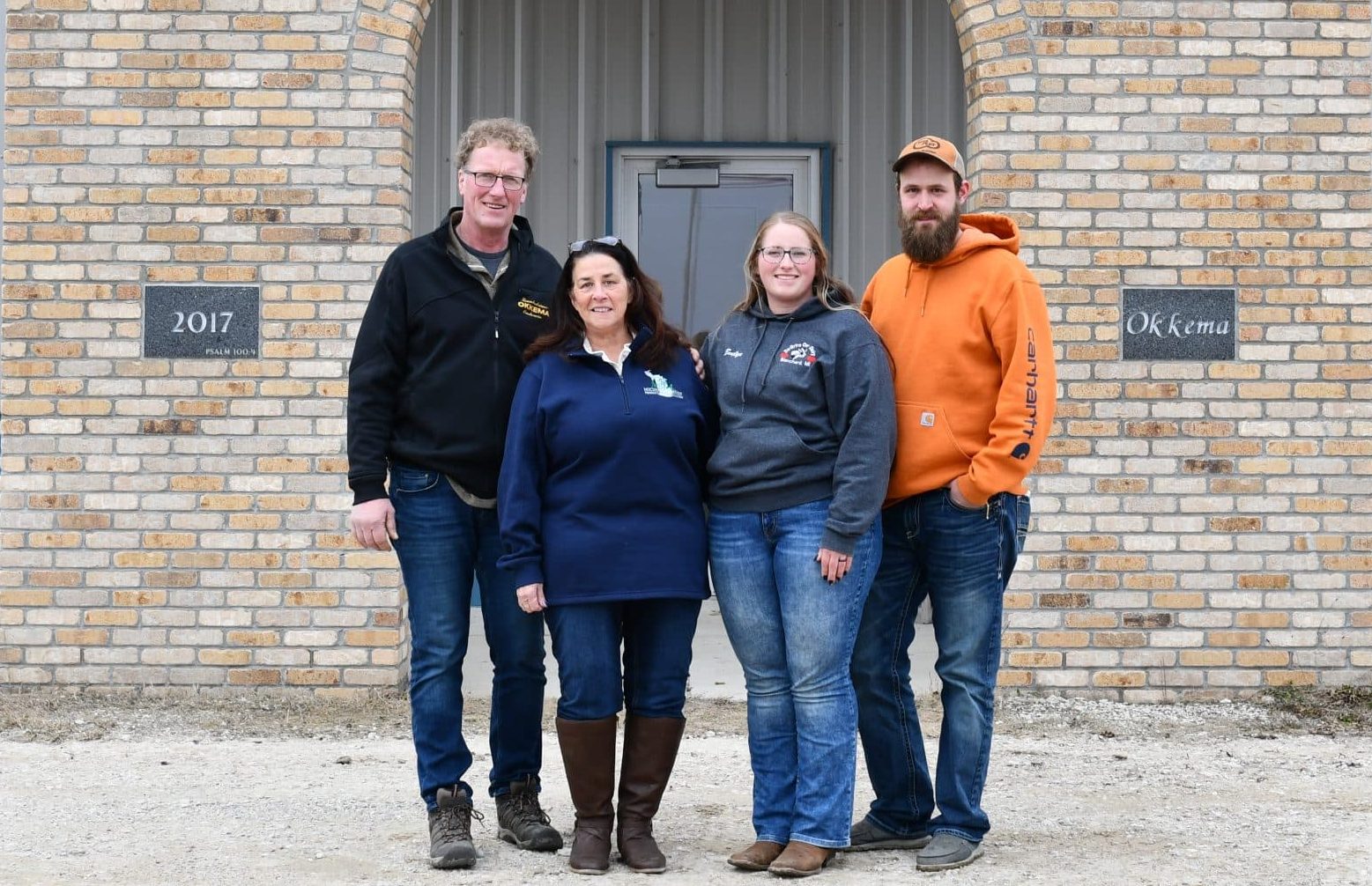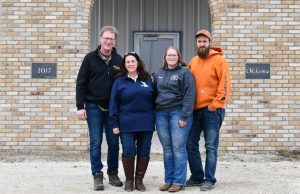
De Grins Oer Dairys’ commitment to family and dedication to quality milk earned them the MMPA Top Quality Award in 2023.
Family. It is everything to Tjerk Okkema. In 1999, fueled by a dream to establish a dairy farm according to his vision, he relocated his wife, Ramona Okkema-Clark, and three children-Evelyn Okkema-Damveld, Cora Okkema and Dirk-Thomas Okkema-from The Netherlands to America. Together they have built a healthy herd in Blanchard, Mich., with milk quality that sets them apart from Michigan Milk Producers Association’s membership, earning them the cooperative’s coveted title of Top Quality Award Winner in 2023.
“We don’t have a somatic cell count goal. Our goal is to have healthy animals that produce high quality milk,” said Tjerk. “Consistency is key. Do the same thing every day.”
The Okkema family places great value in the health of their cows and quality of milk. It is their consistently low average somatic cell count, a common milk quality indicator, of 49,000 proves they’re doing something right.
Family First
Everyone in the Okkemas immediate family is involved on the farm in some form, helping De Grins Oer Dairy succeed.
“The youngest daughter, Evelyn, is completely involved 100% as the herdsperson. Cora, our middle one, is somewhat involved, working mainly with Michigan State University’s Dairy Extension Team. And Dirk, the oldest, is a realtor, but he wants to keep his roots in dairy as he is in charge of the farm’s social media and promotion, and helps out around the dairy when needed,” said Ramona.
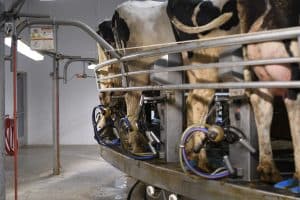 Ramona, former calf feeder and cow handler, now works mostly in the office handling bookkeeping, paperwork, phone calls, etc. As the owner, Tjerk oversees big picture things but doesn’t shy away from getting his hands dirty. “I enjoy working with the cows the most. I like everything except feeding calves. The summer and fall time are especially my favorite, I enjoy being outside.”
Ramona, former calf feeder and cow handler, now works mostly in the office handling bookkeeping, paperwork, phone calls, etc. As the owner, Tjerk oversees big picture things but doesn’t shy away from getting his hands dirty. “I enjoy working with the cows the most. I like everything except feeding calves. The summer and fall time are especially my favorite, I enjoy being outside.”
Aaron Damveld, Agricultural Equipment Foreman, is a jack of all trades, ranging from mechanics and fieldwork to tending to the heifers, he enjoys working with all aspects of the dairy. “I can do almost everything on the farm. I learned a lot from working for my grandfather and uncle growing up.”
The Okkema’s contribute their success to the strength of their family unit and their faith in God.
Ramona states, “Working with family, I mean that’s all I’ve ever done. Your family has your back. No matter how the day ends, you know your family has your back. We all have a silent understanding of what everybody’s going through as far as when it comes to the farm scene.”
The Beginning
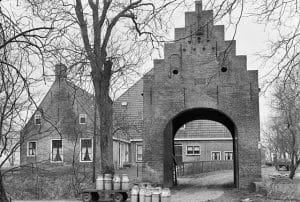
Tjerk and Ramona’s story begins in 1982 when she traveled from America to the Netherlands through a 4-H program. There she met Tjerk who was working with his father on their dairy farm. They married 9 ½
years later, Ramona moved to Achlum, and they grew their family. During their time in the small village in the Netherlands, Tjerk took over operations of the family farm milking almost 50 cows. Not long after
Tjerk came to Ramona with a proposal.
Ramona states, “[Tjerk] came to me and said, ‘What would you think, because of the milk quota here, of moving to America? Fast forward, we went through the immigration process and moved here June 1, 1999. He’s been making improvements and transforming this dairy ever since.”
Tjerk was quick to add, “Well, we showed up June 1st, but I had to do a lot of cleaning before we started milking in August. I started by buying a load of seven milkers and the others were springers that came from Canada. The first load of milk for shipment had a 350,000 somatic cell count as the agitator couldn’t even reach the milk tank.”
They have come a long way since then. Now milking 700 cows, three times a day, in a 40-stall rotary and producing the highest quality of milk.
Today’s Practices
The dairy’s mission reads, “By exemplifying high standards through animal care and progressive practices, we commit ourselves daily to creating quality milk for everyone near and far.” Not only have the Okkema’s stayed true to their mission but they have had success in knowing that they could not have gotten to where they are alone. Before their expansion of the newest barn and rotary in 2017 the family prayed to God over the land. Their accomplishments have been attributed to the profound influence of their faith, with the belief in God playing a pivotal role in their journey to success.
Industry professionals and technology are resources that the family has taken advantage of to be as efficient as possible.
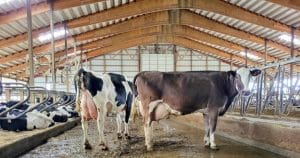
“Every couple of months we have a management meeting and I work personally with a lot of the companies that we hire to help us on the farm such as our vet office, nutritionist, etc.,” Evelyn shared. “The company our nutritionist is with has a calf specialist, so we work closely with them as well.”
The implementation of ear tag monitors five years ago has aided in monitoring herd health and becoming more precise with breeding protocols.
“It tracks the cow’s eating habits, by monitoring how often they’re flipping their ears. If a cow feels sick her ears will droop and may be an indicator that she has mastitis. The tags catch illness a lot faster than somebody just quickly walking through the barn who may overlook her. The sooner we are aware she is ill the quicker we can treat her and have her healthy again”, states Evelyn.
Another technology that has improved milk quality but also solved a labor issue, is the use of a post dip robot arm for the rotary. “The robot has a camera on it so that it can find the teats and it is 99% accurate. We have been able to take two people from the parlor and reduce our somatic cell count,” Tjerk said.
The Okkemas take pride in their cleanliness on the farm. They bed the stalls with clean sand every week and scrape the stalls three times a day.
As members of MMPA for 25 years, they’ve utilized member services such as milker trainings and educating employees through the Dairy Care Academy Program. “I utilize the Dairy Care Academy courses for the calf feeders and MMPA’s Spanish milker trainings for the people in the parlor,” states Evelyn.
“The key to improving milk quality is in the details,” Tjerk said. “The little things and the consistency. If you’re doing it right, you’re doing it right. Our goal is not to have the lowest somatic cell count, but to produce high quality milk.”
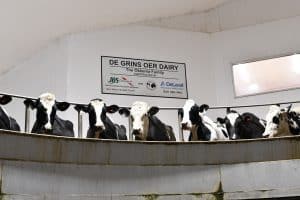
This article was originally published in the March/April 2024 issue of the Milk Messenger. Subscribe »

